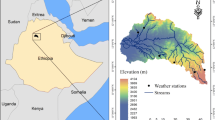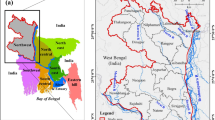Abstract
The most reliable source of fresh water is groundwater (GW). The GW sources are under rigorous threat owing to several criteria like elevated population, urbanization, and industrialization. A vital role was played by climate change in the quality and quantity of GW resources. Also, the parameters affecting the GW recharge were largely influenced by climate variability. A decline in the GW levels was elevated by the unreliable monsoons along with the surface water resources’ poor quality. Hence, recognizing along with delineating the groundwater potential zone (GWPZ) is necessary to augment the GW source. Rather than surface water, the GW serves as the major source for agricultural along with domestic purposes in the Mahabubnagar District of Telangana district in which the study is executed. Soil, land use land cover (LULC), lineaments, lineament density (LD), stream density, geomorphology, rainfall, and slope were the parameters engendered as diverse thematic layers (TL) in the geographical information systems (GIS). To obtain GWPZ, those features are fed to weighted overlay analysis. Additionally, very low, low, moderate, high, and very high were the ‘5’ distinct classes in which GWP has been categorized. The study’s outcomes exposed that moderate and high areas covered a percentage of 43.89 and 51.67, correspondingly. Moreover, under this category, the district’s main part falls. Thus, the GWPZ in the study area was depicted by the outcomes that aid in better planning and management of GW resources.














Similar content being viewed by others
Availability of data and materials
Data sharing is not applicable to this article as no datasets were generated or analyzed during the current study.
References
Ahmad I, Dar MA, Fenta A, Halefom A, Nega H, Andualem TG, Teshome A (2021) Spatial configuration of groundwater potential zones using OLS regression method. J Afr Earth Sci 177(1–9):2021. https://doi.org/10.1016/j.jafrearsci.2021.104147
Al-Djazouli MO, Elmorabiti K, Rahimi A, Amellah O, Fadil OAM (2020) Delineating of groundwater potential zones based on remote sensing, GIS and analytical hierarchical process a case of Waddai, Eastern Chad. Geo J. https://doi.org/10.1007/s10708-020-10160-0
Arshad A, Zhang Z, Zhang W, Dilawar A (2020) Mapping favorable groundwater potential recharge zones using a GIS-based analytical hierarchical process and probability frequency ratio model a case study from an agro-urban region of Pakistan. Geosci Front 11(5):1805–1819. https://doi.org/10.1016/j.gsf.2019.12.013
Arya S, Subramani T, Karunanidhi D (2020) Delineation of groundwater potential zones and recommendation of artificial recharge structures for augmentation of groundwater resources in Vattamalaikarai basin, South India. Environ Earth Sci 79(5):1
Bera A, Mukhopadhyay BP, Barua S (2020) Delineation of groundwater potential zones in Karha river basin, Maharashtra, India using AHP and geospatial techniques. Arab J Geosci 13(15):1–21. https://doi.org/10.1007/s12517-020-05702-2
Berhanu KG, Hatiye SD (2020) Identification of groundwater potential zones using proxy data case study of Megech watershed, Ethiopia. J Hydrol Region Stud 28:1–20. https://doi.org/10.1016/j.ejrh.2020.100676
Dar T, Rai N, Bhat A (2020) Delineation of potential groundwater recharge zones using analytical hierarchy process (AHP). Geol Ecol Landsc. https://doi.org/10.1080/24749508.2020.1726562
Das S (2017) Delineation of groundwater potential zone in hard rock terrain in Gangajalghati block, Bankura district, India using remote sensing and GIS techniques. Model Earth Syst Environ 3:1589–1599. https://doi.org/10.1007/s40808-017-0396-7
Das B, Pal SC, Malik S, Chakrabortty R (2019) Modeling groundwater potential zones of Puruliya District, West Bengal, India using remote sensing and GIS techniques. Geol Ecol Landsc 3(3):223–237
Gnanachandrasamy G, Zhou Y, Bagyaraj M, Venkatramanan S, Ramkumar T, Wang S (2018) Remote sensing and GIS based groundwater potential zone mapping in Ariyalur District, Tamil Nadu. J Geol Soc India 92(4):484–490. https://doi.org/10.1080/24749508.2018.1555740
Goitsemang T, Das DM, Raul SK, Subudhi CR, Panigrahi B (2020) Assessment of groundwater potential in the Kalahandi district of Odisha (India) using remote sensing, geographic information system and analytical hierarchy process. J Indian Soc Remote Sens 48(12):1739–1753. https://doi.org/10.1007/s12524-020-01188-3
Hamdani N, Baali A (2020) Characterization of groundwater potential zones using analytic hierarchy process and integrated geomatic techniques in Central Middle Atlas (Morocco). Appl Geomat 12(3):323–335. https://doi.org/10.1007/s12518-020-00300-z
https://link.springer.com/article/10.1007%2Fs12665-020-8832-9
Igwe O, Ifediegwu SI, Onwuka OS (2020) Determining the occurrence of potential groundwater zones using integrated hydro-geomorphic parameters GIS and remote sensing in Enugu state, Southeastern Nigeria. Sustain Water Resour Manag 6:1–14. https://doi.org/10.1007/s40899-020-00397-5
Jesiya NP, Gopinath G (2020) A fuzzy based MCDM–GIS framework to evaluate groundwater potential index for sustainable groundwater management a case study in an urban-periurban ensemble Southern India. Groundw Sustain Dev 11:1–12. https://doi.org/10.1016/j.gsd.2020.100466
Jhariya DC, Kumar T, Gobinath M, Diwan P, Kishore N (2016) Assessment of groundwater potential zone using remote sensing, GIS and multi criteria decision analysis techniques. J Geol Soc India 88(4):481–492. https://doi.org/10.1007/s12594-016-0511-9
Kaur L, Rishi MS, Singh G, Thakur SN (2020) Groundwater potential assessment of an alluvial aquifer in Yamuna sub-basin (Panipat region) using remote sensing and GIS techniques in conjunction with analytical hierarchy process (AHP) and catastrophe theory (CT). Ecol Ind 110:1–19. https://doi.org/10.1016/j.ecolind.2019.105850
Magesh NS, Chandrasekar N, Soundranayagam JP (2012) Delineation of groundwater potential zones in Theni District, Tamil Nadu using remote sensing GIS and MIF techniques. Geosci Front 3(2):189–196. https://doi.org/10.1016/j.gsf.2011.10.007
Miraki S, Zanganeh SH, Chapi K, Singh VP, Shirzadi A, Shahabi H, Pham BT (2018) Mapping groundwater potential using a novel hybrid intelligence approach. Water Resour Manag 33:281–302. https://doi.org/10.1007/s11269-018-2102-6
Nag SK, Ghosh P (2012) Delineation of groundwater potential zone in Chhatna block, Bankura District, West Bengal, India using remote sensing and GIS techniques. Environ Earth Sci 70:2115–2127. https://doi.org/10.1007/s12665-012-1713-0
Nejad SG, Falah F, Daneshfar M, Haghizadeh A, Rahmati O (2015) Delineation of groundwater potential zones using remote sensing and GIS-based data driven models. Geocarto Int 32(2):167–187. https://doi.org/10.1080/10106049.2015.1132481
Omolaiye GE, Oladapo IM, Ayolabi AE, Akinwale RP, Akinola AA, Omolaye KL, Sanuade OA (2020) Integration of remote sensing GIS and 2D resistivity methods in groundwater development. Appl Water Sci 10(6):1–24. https://doi.org/10.1007/s13201-020-01219-x
Panahi M, Sadhasivam N, Pourghasemi HR, Rezaie F, Lee S (2020) Spatial prediction of groundwater potential mapping based on convolutional neural network (CNN) and support vector regression (SVR). J Hydrol 588:1–12. https://doi.org/10.1016/j.jhydrol.2020.125033
Qadir J, Bhat MS, Alam A, Rashid I (2020) Mapping groundwater potential zones using remote sensing and GIS approach in Jammu Himalaya, Jammu and Kashmir. Geo J 85(2):487–504. https://doi.org/10.1007/s10708-019-09981-5
Rahmati O, Avand M, Yarian P, Tiefenbacher JP, Azareh A, Buif DT (2020) Assessment of gini, entropy, and ratio based classification trees for groundwater potential modeling and prediction. Geocarto Int 37(12):3397–3415. https://doi.org/10.1080/10106049.2020.1861664
Saranya T, Saravanan S (2020) Groundwater potential zone mapping using analytical hierarchy process (AHP) and GIS for Kancheepuram district, Tamil Nadu, India. Model Earth Syst Environ 6:1–18. https://doi.org/10.1007/s40808-020-00744-7
Sunandana Reddy M, SadaSivudu J, Rajesh P (2018) Application of geo-spatial technologies in identification of groundwater potential zones. IJSART 4(1):230–235
Tiwari RN, Kushwaha VK (2020) An integrated study to delineate the groundwater potential zones using geospatial approach of Sidhi area, Madhya Pradesh. J Geol Soc India 95:520–526. https://doi.org/10.1007/s12594-020-1471-7
Tolche AD (2020) Groundwater potential mapping using geospatial techniques a case study of Dhungeta-Ramis sub-basin, Ethiopia. Geol Ecol Landsc 5(1):1–16. https://doi.org/10.1080/24749508.2020.1728882
Xu H, Wang D, Ding Z, Deng Z, Shi Y, Yu D, Li J, Ni B, Zhao X, Ye X (2020) Application of convolutional neural network in predicting groundwater potential using remote sensing a case study in Southeastern Liaoning, China. Arab J Geosci 13(15):1–12. https://doi.org/10.1007/s12517-020-05585-3
Acknowledgements
We thank the anonymous referees for their useful suggestions.
Funding
This work has no funding resource.
Author information
Authors and Affiliations
Contributions
All authors contributed to the study conception and design. Material preparation, data collection and analysis were performed by AC, Dr. VM, Dr. KHVDR. The first draft of the manuscript was written by AC and all authors commented on previous versions of the manuscript. All authors read and approved the final manuscript.
Corresponding author
Ethics declarations
Conflict of interest
The authors declare that they have no conflict of interest.
Ethical approval
This article does not contain any studies with human participants or animals performed by any of the authors.
Consent of publication
Not applicable.
Additional information
Publisher's Note
Springer Nature remains neutral with regard to jurisdictional claims in published maps and institutional affiliations.
Rights and permissions
Springer Nature or its licensor (e.g. a society or other partner) holds exclusive rights to this article under a publishing agreement with the author(s) or other rightsholder(s); author self-archiving of the accepted manuscript version of this article is solely governed by the terms of such publishing agreement and applicable law.
About this article
Cite this article
Choudhury, A., Mahammood, V. & Rao, K.H.V.D. Ground water potential zone assessment using geospatial technique and identification of artificial recharge sites: a case study of Mahabubnagar District of Telangana. Model. Earth Syst. Environ. 9, 1709–1723 (2023). https://doi.org/10.1007/s40808-022-01575-4
Received:
Accepted:
Published:
Issue Date:
DOI: https://doi.org/10.1007/s40808-022-01575-4




